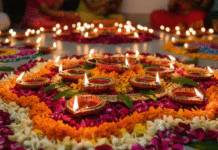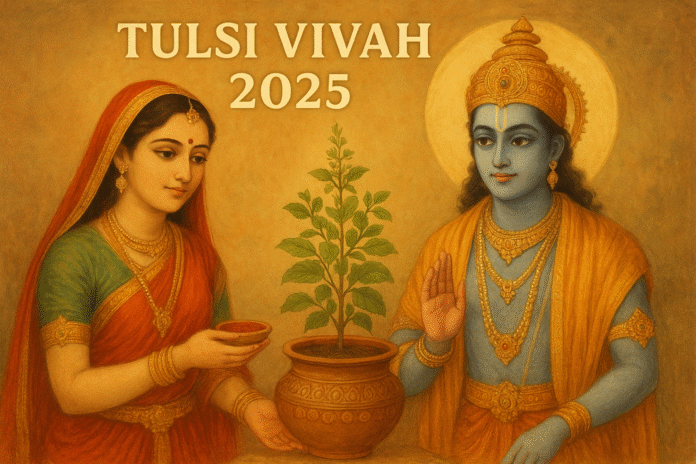
A chill in the air marks the month of Kartik all over India. The smell of holy basil wafts softly in through the windows; thus, begins the Tulsi Vivah 2025. This auspicious event is slated for November 2, 2025, hinting at an excited romantic Valentine’s festival for Hindus, when the Tulsi plant (Ocimum sanctum) is ceremonially wedded to Lord Vishnu or to his incarnated form, Lord Krishna. The entire court will be decorated as a bridal mandap with the Tulsi plant adorned like a shimmering bride and a Shaligram stone representing the groom, thus bringing nature, faith, and tradition together. This ceremony is called Tulsi Vivah: An act deeply revered in every household, and it holds deep symbolic meaning. It marks the closing of Chaturmas, heralds the wedding season, and fills hearts with joy and devotion.
This extensive guide details all the information one is interested in concerning the significance of Tulsi Vivah: grandeur on history and legends associated with it, its deep cultural importance and legacy cemented in Indian heritage, stepwise Tulsi Vivah puja vidhi, the shubh muhurat for 2025, regional practices, essentials, health benefits, ongoing culture, and trending customs.
The Allure of the Tulsi Vivah: Myths and Legends – Their Roots in Puranic Lore
The tulsi vivah history was found in ancient Hindu texts like Padma Purana and Skanda Purana, which worship the Tulsi that represents divine purity. The festival is celebrated on the Dwadashi (12th day) of Shukla Paksha in Kartik and denotes centuries of devotion towards nature’s purity.
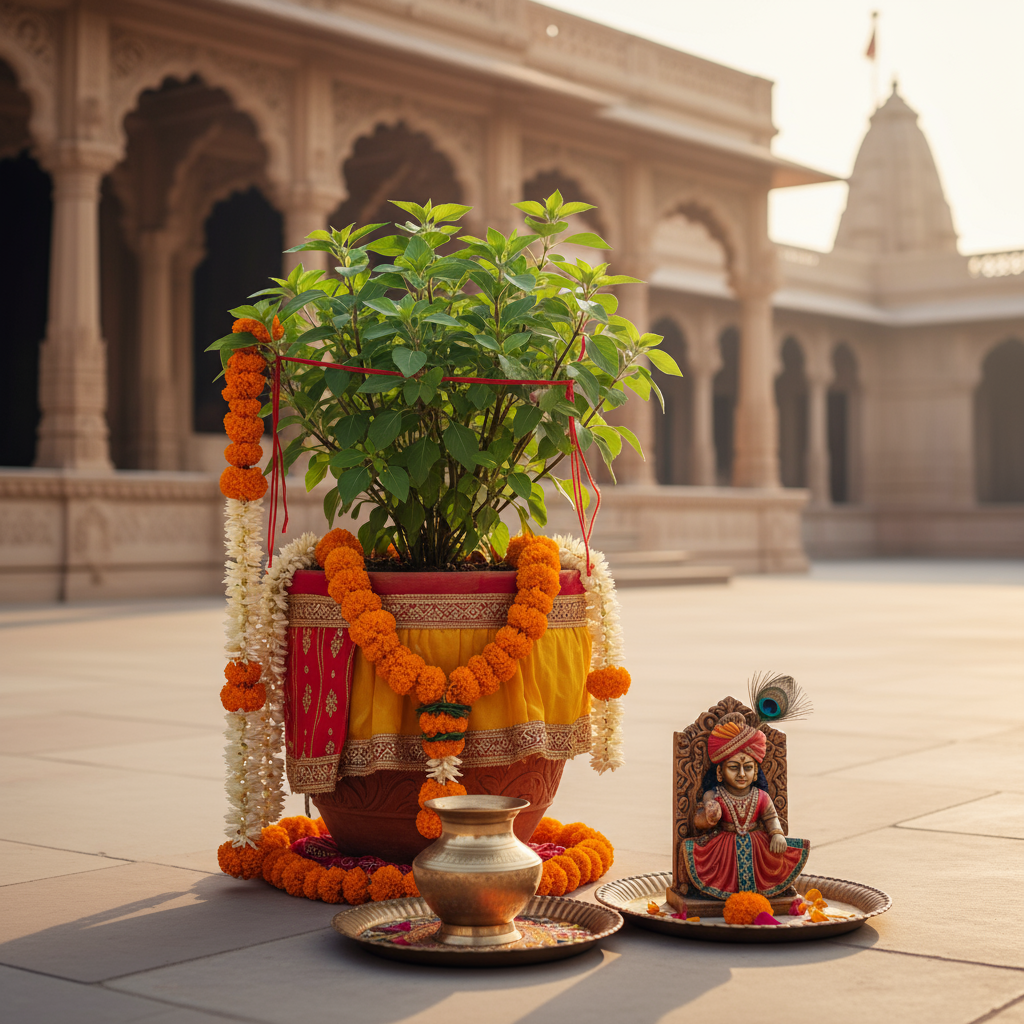
It narrates the stories of Tulsi Vivah, telling of Devi Vrinda, the beloved wife of demon king Jalandhar, who drew strength from her vow of chastity and piety. As Jalandhar began to trouble the gods, they called upon Lord Vishnu for assistance, and Vishnu assumed the form of Jalandhar and went to meet Vrinda, thus unwittingly breaking her vow. She found out about this deception, and furious, cursed Vishnu that he would turn into black stone (Shaligram). In regret, Vishnu blessed her that her ashes would become the Tulsi plant, always dear to him, and he would marry her every year. So, Tulsi Vivah is the eternal union of the curse and conversion into an act of devotion.
Another one tells of Tulsi being a form taken by the Goddess Lakshmi to marry Vishnu. Some say that in retrospect, Krishna promised Radha and in that case, the Tulsi stands for unwavering bhakti (devotion). These stories of Tulsi Vivah talk of sacrifice, purity, and divine love and hence have been invoked as the foundation of the Vaishnava traditions. The festival gained much prominence during the time of the Bhakti movement around the medieval ages and its wide popularity in texts like Ramcharitmanas by the great saint Tulsidas, who extolled the virtues of Tulsi.
In this way, all the stupendous spiritual-cultural significance of Tulsi Vivah acts as a marriage between jiva and the Supreme (Paramatma), connoting thereby much more than the marriage ceremony.
The worthiness of Tulsi Vivah is further celebrated and energized. The event takes on monumental value since it signifies a further opportunity for joining jiva with Paramatma.
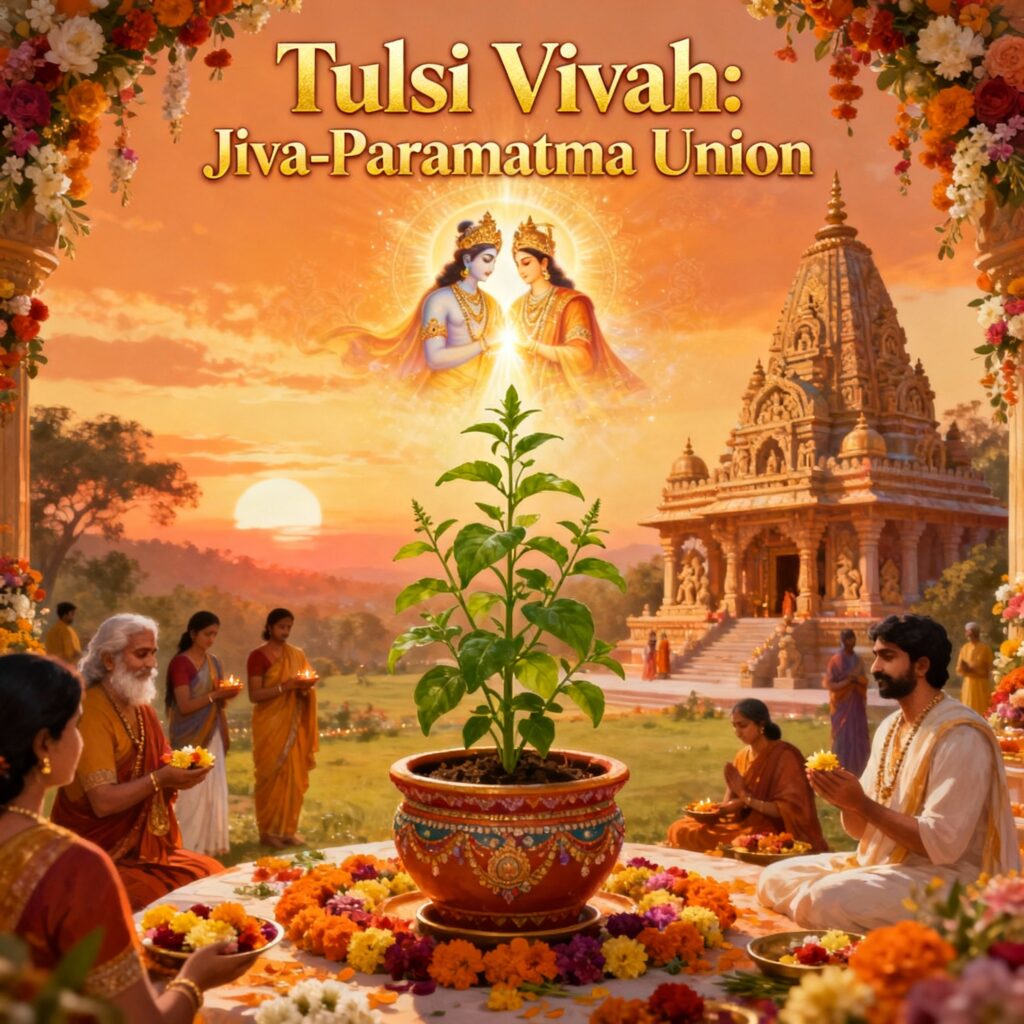
It has great spiritual and cultural meaning of Tulsi Vivah which serves as another conjugation of the jiva with Paramatma beyond the marriage ceremony.
In Indian tradition, Tulsi is Vishnu Priya, embodying sattva. Performing this ceremony becomes like Kanyadaan, the highest dharma, thus filling devotees with immense punya-karmas.
In spiritual dimensions, Tulsi Vivah importance stands for the awakening of bhakti, destruction of negativity, and welcoming of prosperity. It marks the end of Chaturmasa, where Lord Vishnu “wakes up” from his yogic sleep to get back to the worldly activities of weddings. It imparts friendly feelings among members of a family, where married women pray for their husbands’ well-being, while unmarried ones pray for the ideal life-partner. Cultural connotations confirm eco-spiritualism – the presence of a Tulsi plant in every Hindu courtyard absorbs Vastu doshas and evil plants.
In Ayurvedic legend, the uses of Tulsi are renowned. It possesses, it is said, the power of a martyr for all plants, assisting in raising the body’s immunological powers, imparting freshness to the air, curing coughs, stress, and other disorders. Its main chemical eugenol and ursolic acid are credited with anti-inflammatory and antioxidant properties. The cultural relevance of Tulsi Vivah in modern times provides support for the practice of organic gardening as a means for sustainable living within urbanized areas. Even more, UNESCO recognition of this form of celebration as part of the intangible cultural heritage enhances community bonding, cutting across the barriers of caste and regionality.
Tulsi Vivah 2025 Muhurat and Puja Vidhis: Step-by-Step Guide to The Divine Ceremony
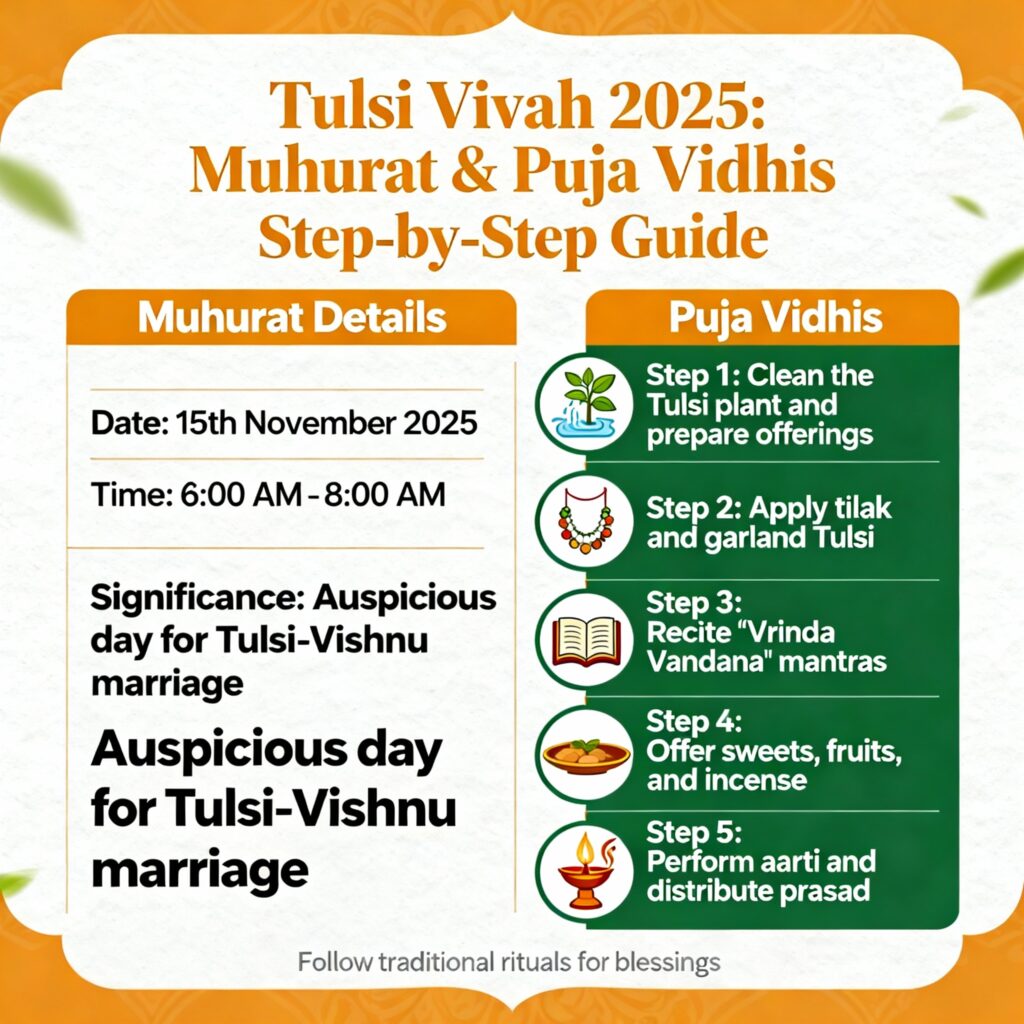
On Tulsi Vivah 2025 date: Be part of Friday, November 2, 2025, Dwadashi of Kartik Shukla. The shubh muhurat will usually fall after sunset during the Pradosh Kaal (the twilight) i.e. after 5.30 PM and before 8.00 PM IST (this must be modified with respect to the local panchang, as variations are considerable from place to place). If Dwadashi remains for two days, go for the day just after the D-day itself of Prabodhini Ekadashi in essence.
The following are the milestone details concerning the Tulsi Vivah rituals for one to celebrate it in an authentic manner:
Preparation
- Cleanse the home and Tulsi courtyard (Tulsi Vrindavan) before the day of the ritual.
- Fasting till the end of Puja (optional, yet auspicious).
- Collect the following: Tulsi plant; Shaligram stone or Vishnu/Krishna idol (husband); sugarcane or amla sprig (alternatively); red cloth; flowers (lotus, marigold); fruits; sweets; vermilion; turmeric; rice; sacred thread; lamps; incense; betel nuts; coconut; and prasad (kheer or fruits).
Step-Wise Puja Vidhis
- Sankalpa and Invocation
- Mandap Setup
- Vivah Ceremony
- The Aartis and Mantras
- Kanyadaan
- Offering of Prasad
- Final Actions
Dos: Be pure-hearted and involve family. Don’ts: No non-veg, no alcohol; don’t argue during Puja. This Tulsi Vivah worship brings Vishnu’s everlasting presence into the home.
The Regional Variants of Tulsi Vivah Across India: A Tapestry of Devotion
Tulsi Vivah customs vary dramatically, giving each approach its flavor while preserving some semblance of a core essence.
- North India (UP, Bihar)
- Maharashtra (“Tulshi Lagna”)
- Gujarat
- South India (Tamil Nadu, Andhra)
- Bengal and East
- Rajasthan
These regional Tulsi Vivah celebrations proclaim unity among communities, with diaspora adapting through virtual pujas.
Essential Items and Recipes for Tulsi Vivah: Practical Preparations
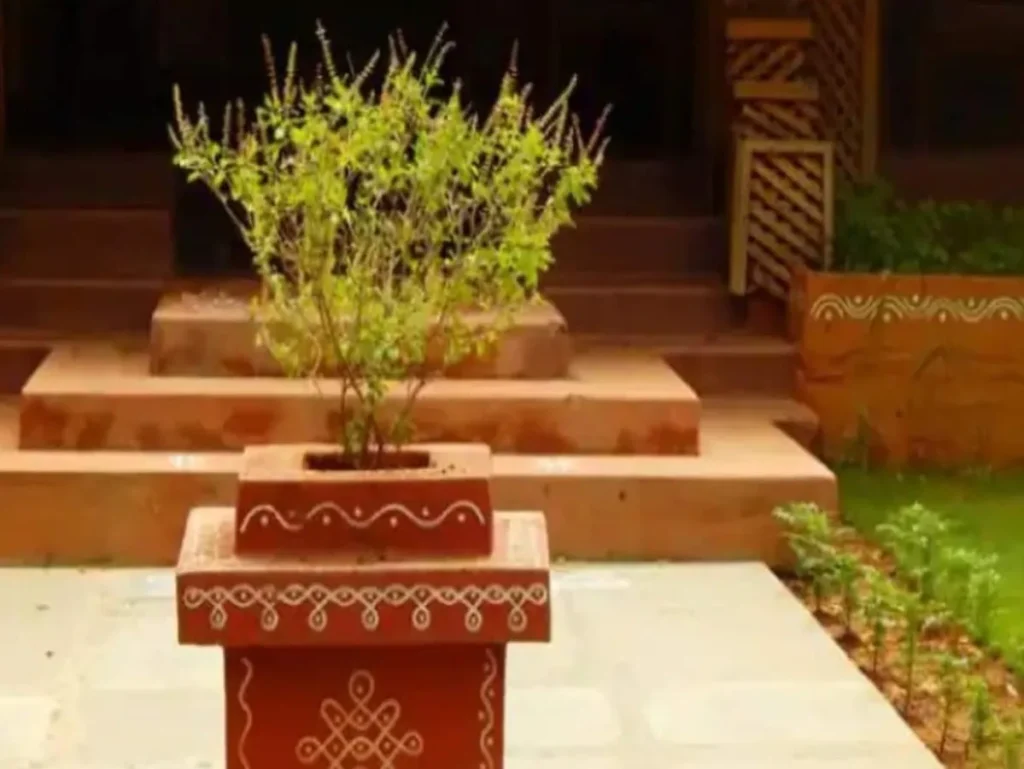
Fill up: Holy basil plant, idols, puja samagri (incense, camphor), fruits, sweets. Use clay diyas for a more eco-friendly touch.
Try out these Tulsi Vivah recipes:
- Tulsi Prasad Kheer
- Fruit Chaat
Modernized Tulsi Vivah: Tradition Moved Into Today
Contemporary Tulsi Vivah 2025 has muhurat apps, e-mandaps, and sharing through social media as #TulsiVivah2025. Families in urban areas organize virtual get-togethers, while wellness enthusiasts appraise Tulsi’s herbal teas for their benefits in stress relief.
Conclusion: Embrace the Divine Harmony of Tulsi Vivah 2025
This Tulsi Vivah to be held on November 2, 2025, will illuminate your home with the light of devotion. From the ancient tale of Vrinda to the rituals from the heart, the festival brings spirituality, prosperity, and peace. So, observe with deep faith, nurture your Tulsi, and see miracles unfold.
Shubh Tulsi Vivah — may the divine couple give wings to the eternal dance of the soul!




